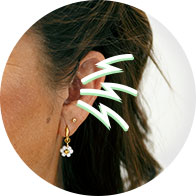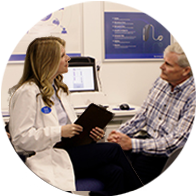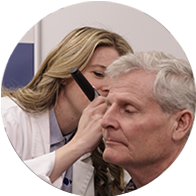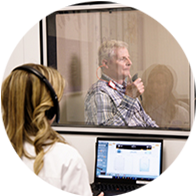
Free hearing test
When it comes to staying healthy, having a hearing test is just as important as any other health check up. If you suspect that you have hearing loss, you are welcome to book a free hearing test with one of our hearing care professionals.
6 signs you should consider a hearing test
The signs of hearing loss may be slow to develop and difficult to identify, or they can also be sudden and obvious. If you are aware of the general signs of hearing loss, then you will be in a better place to recognize problems.
1. Following conversations is difficult
You have difficulty following group conversations (or when background noise is present)
2. Phone conversations are unclear
You have trouble following phone conversations and often have to ask people to repeat what they say
3. People seem to be mumbling
You often ask people to repeat themselves. Sounds seem unclear, or people sound like they are mumbling
4. Difficulty locating sounds
You have difficulty locating where sounds are coming from
5. Signs of tinnitus
You experience ringing or buzzing sounds in your ears (called tinnitus)
6. TV is difficult to hear
Your friends and family say you turn the television up too loud

Would you like to get your hearing tested?
Book a free hearing test - No obligations - Same-day results
Question 1 of 1
Have you had a hearing test within the last 12 months?
3 ways to book a hearing test
Request a call back
Fill out an online form to request a call back within two business days. Our customer service will then assist you in booking your hearing test.
Request a call back
Book an appointment online
Using our online booking tool, book a free hearing test online at your preferred time.
Book an appointment
Find a hearing centre
Use our hearing centre locator to find the closest hearing centre.
Find the closest centre
3 reasons to test your hearing at HearingLife
1
Professionals in hearing care
Our certified hearing professionals conduct non-binding hearing tests with Real Ear Measurements and same-day results.
2
Quality hearing aid solutions
We offer a broad selection of the latest digital hearing aids from multiple award-winning brands - risk-free, 30-day trials.
3
Aftercare services
As a HearingLife client, you are entitled to free hearing aid batteries, and adjustments, cleaning and repair services at the lowest price, satisfaction guaranteed!

Before, during and after a hearing test
What to expect at a hearing test
20 minutes
1. Congratulations! You've booked your hearing test
20 minutes
2. Discuss hearing concerns, medical history and lifestyle factors
5 minutes
3. Physical ear examination
20 minutes
4. Comprehensive hearing assessment
15 minutes
5. Go over your results and recommended solutions














